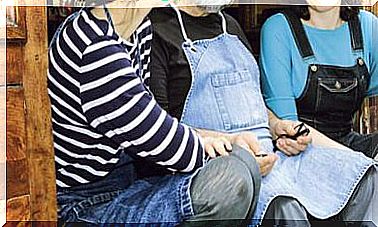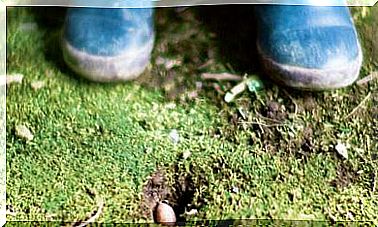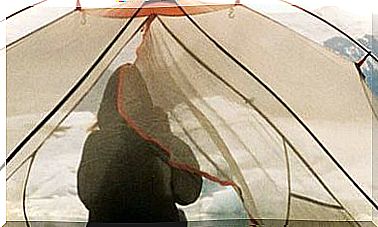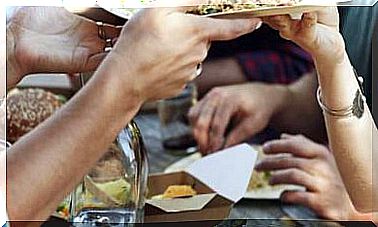The Power Of Compassion: That Invisible Fabric That Sustains The World
Compassion is a natural predisposition that, if empowered, protects from destructive emotions and brings serenity to life.

Every day, at all times, all over the world, there are millions of spontaneous acts of kindness. In the human being there is an instinctive tendency towards kindness and compassion that we often do not perceive, because we take it for granted and because the media tend to direct our attention towards violent and raucous events.
An invisible fabric of goodness sustains the cohesion of society, families, friendships, and loves. It is invisible, but in today’s turbulent world it is worth remembering that it is there.
Compassion and kindness, by nature
Psychology and neurology show us, as the psychologist Daniel Goleman explains, that the brain has a predisposition towards goodness. In the example set a century ago by Finnish scientist Edvard Westermarck, just as we cannot help feeling pain if fire burns us, we cannot help feeling compassion for our fellow men.
The Chinese sage Mencius illustrated it with the anguish and compassion that any sane person would feel if they saw a child about to fall into a well. Our spontaneous tendency is to feel bad about the suffering of others and try to alleviate it.
From that natural force the power of love is born. The empathy is the ability to resonate with what feels another being. And it can turn out to be exhausting (as doctors, nurses, and activists dedicated to the common good, among others, sometimes experience) if it is not infused with compassionate love and deep trust in the ultimate goodness of human nature.
Techniques for activating compassion
Learning techniques for activating compassion, such as those found in Buddhism and other meditative traditions, can be of great help to those caring for sick or troubled people.
As the psychologist Christophe André points out: “We need the strength and lightness of compassion. The more lucid we are about the world, the more we accept to see it as it is, the easier it is to recognize that we cannot cope with all the suffering that we encounter in the course. of our lives without this lightness and this strength. “
One of the figures who best embodies the power of compassion is the Dalai Lama. The American psychologist Daniel Goleman dedicated his book, The Force of Compassion (Kairós, 2014) to him. Here compassion is to be understood not as an invitation to sadness (pity), but as altruistic benevolence , as an active form of kindness.
Compassion feels good to those who practice it, to the point that the Dalai Lama is recognized as a model of positive emotions.
The psychologist Paul Ekman, the world’s leading expert in the study of the expressiveness of the human face, affirms that he has never met anyone who has as much fun as him, and that his face is capable of expressing all kinds of feelings, without repressing nothing, empathizing with everything he hears, to immediately return to his usual state of equanimity and joy.
But the Dalai Lama was not always like this. He has been able to develop this ability thanks to decades of meditative and contemplative practice, as he explains: “Today, compared to twenty or thirty years ago, I have much more mental stability.”
“Sure, the irritation comes on every now and then, but it goes away quickly. When bad news comes, I feel uncomfortable for a few minutes, but then I don’t feel too agitated.”
Send love and compassion
Life inevitably brings shocks, and a hallmark of our well-being is this ability to quickly regain emotional stability.
In laboratory experiments, such as those of Tania Singer in Maastricht and those of Richard Davidson in Madison, empathy with a suffering person has been shown to activate areas of the brain related to discomfort and negative emotions.
On the other hand, if through empathy the light of compassion shines , actively radiating a desire for well-being for the person who suffers, areas of the brain related to positive emotions, groundedness and maternal love are activated.
The Buddhist monk Matthieu Ricard, author of In Defense of Happiness (Urano, 2011), has participated in some such experiments. On one occasion, hooked up to a functional MRI machine, he focused on the horrors he had seen the day before in a documentary about Romanian orphans.
After an hour feeling empathy but without activating his capacity for compassion for those orphans, the situation began to be unbearable. But the moment he began to meditate and send them love and compassion, everything changed.
The images of the orphans’ suffering were still there, but now they were infused with love and a craving to help them, imagining that he was holding them and finding ways to improve their situation.
The most experienced meditators are capable of showing, according to the French researcher Antoine Lutz, greater interest in the suffering of others, but this does not make them feel worse, but rather feel more love and compassion.
This ability is at the bottom of human nature, waiting for us to let it grow. From the cynicism that is often advocated in today’s world, it could be objected that this is only an inner experience. Even if it were, it would already have an immediate benefit for the person who has that experience (the MRI corroborated the transformation that Matthieu Ricard felt).
In a situation of discomfort, in addition, we all know from experience that we prefer that the person who accompanies us does not transmit negative emotions (sadness, fear, anxiety), which would aggravate the situation, but a relaxed and positive attitude, focused not on the problem but in acceptance, resilience and determination to do what needs to be done.
Albert Schweitzer, a French doctor and philosopher of German origin who developed an ethic around the idea of “reverence for life” and Nobel Peace Prize in 1952, once stated before a group of schoolchildren: “The only ones among you who they will be really happy, you will be the ones who seek and find a way to serve “.
At the bottom of our interior there is always a space of freedom that allows us to orient ourselves towards the light or towards the dark.
A Native American told his grandson that he felt there were two wolves fighting inside him. “One of the wolves is violent, full of revenge. The other is loving and compassionate.” The grandson asked: “Which of the wolves will win in your heart?” “The one you feed,” replied the old man.
Teach “emotional hygiene”
Educating the heart is what the Dalai Lama proposed in a talk at Princeton University. “Our educational model is oriented towards materialistic values,” said the religious leader. “To lead a healthy life we need an education oriented towards inner values.” One aspect is the “emotional health”.
“At school we teach physical hygiene. Why not teach emotional hygiene?” It is about learning how to free ourselves from the brutalization of emotions such as anger, obsessions, despair, frustration or apathy.
The negative emotions is natural that sometimes arise, it is not necessary to condemn, but regularly clean: the mind appreciates it as much as the body appreciates a good shower. Emotional hygiene teaches you to identify destructive impulses early and cover them with serenity and moderation.
The Dalai Lama gives as an example his displeasure at how the Chinese army repressed Tibetan protesters in 2008. His anger soon turned to serenity and compassion in the face of negative emotions from Chinese officials.
“There is also anger in me,” he says. “However, I try to remember that anger is a destructive emotion: it destroys peace of mind and physical health. We should not welcome it or consider it natural or friendly. Only with a calm mind is it possible to open the heart and use the mind well.”
It is easier to find solutions or alternatives with a calm mind. But, how to bring this wisdom to the population? The best alternative is school …
In Canada, 90% of British Columbia schools offer “social and emotional learning” (SEL) programs inspired by the Dalai Lama, teaching, for example, anger management, to develop empathy and to cooperate with others.
A study carried out with 270,000 students, which compared those who had taken these programs with students who had not had such an opportunity, showed remarkable effectiveness : increased class attendance, improved relationships, decreased bullying and violence, and also , an 11% increase in academic results.
A more humane economy
The true nature of the human being is much more cooperative and altruistic than competitive and selfish: we are much more Homo reciprocans than Homo economicus .
But the two great economic systems that still predominate put the economy and other abstractions ahead of life and people, reduce the world to a sum of objects, increase inequalities and do not generate true satisfaction.
We can build economic and social systems that are based on the best and not the worst of human nature, which are at the service of people’s self-realization, eliminating scourges such as unemployment and putting the economy and finances at the service of humanity and the planet.
A key reference is E. E Schumacher’s classic Small is Beautiful. An economy as if people matter (Akal, 2011). Fifty years ago he pointed out that our economic system is based on greed and envy, and contrasted it with “Buddhist economics.”
This is based on just subsistence and the middle way between the extremes, and is oriented to satisfy true human needs and maximize inner well-being. When the Dalai Lama heard that the number of billionaires in the world continues to rise, he was puzzled. “Why would anyone want so much money?” He asked.









